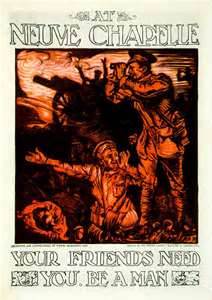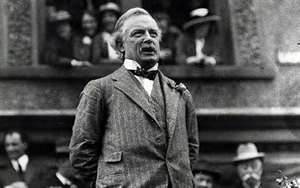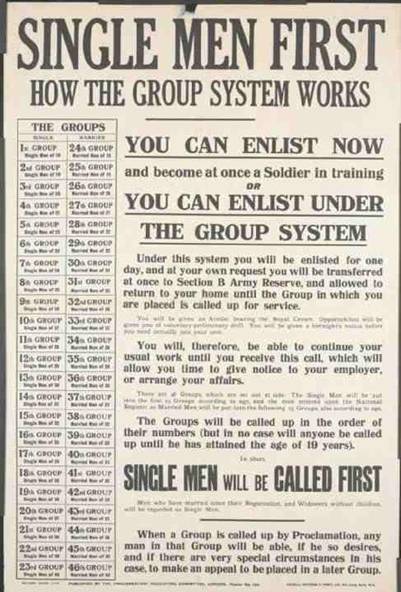by Pete Goddard and Atul Hatwal
It was the start of 1915 and something wasn’t quite right. Contrary to the confident predictions of the press, the government and most of the Labour party, Fritz had not been sent packing and the government began to regret printing quite so many invitations to “1915’s big victory conga through no man’s land”.
In fact, to the uninformed bystander everything seemed to have ground to a halt in a bloody stalemate of trench-based slaughter.
Fortunately, the British public were very well informed by a national press that was still insisting victory was just around the corner.
For example, when the British attacked Neuve Chapelle at the start of March the Daily Express headline boomed “German’s routed…great victory at Neuve Chapelle”.
Which was sort of true, if your idea of victory was the loss of 13,000 men to gain two pocketfuls of French gravel. The offensive advanced 2km and then was abandoned due to the catastrophic losses.
With successes like these, it was no wonder the worry-o-meter in government was swinging towards the red. No-one had planned for war that devoured resources at such a rate. Not only were more troops needed, demand for munitions was outstripping production.
Keen to secure supply, in mid-March, chancellor of the exchequer Lloyd-George summoned the unions to the treasury to discuss a no-strike agreement. In return for this, the government would guarantee the resumption of normal rights after the war and limitation of profits in industries such as munitions during the war.
In other words, thanks to the war, the government suddenly realised that workers were not just a cost to be minimised to ensure good profits, they were a crucial cog in the war machine.
In the spirit of “all in it together” the unions accepted the Lloyd-George’s offer and the government convened a national labour advisory committee to advise the government on resolving industrial problems. The chairman of this committee – Arthur Henderson
Henderson seemed intent on setting a record for the number of simultaneous jobs held by a politician. On top of the prosaic duties of representing the people of Barnard Castle as an MP, he was leader of the Labour party, secretary to the Labour party, industrial adviser to the government – in which the Labour party was not represented – and secretary to the British section of the International Socialist movement.
As if that wasn’t enough, a new employment opportunity soon presented itself.
In May, following an even bigger Neuve Chapelle-style “victory” (or, to the non-newspaper layman, “disaster”) at Gallipoli, Asquith sought to reconstitute his government as a coalition with both the Tories and Labour.
Within Labour, this chance to taste government stirred deeply conflicting responses.
The anti-war left, led by Ramsay Macdonald was hostile. They were resolutely opposed to joining the government which, after all, was the government that got us into war in the first place. Macdonald’s great fear was that this national government would be just a prelude to conscription.
Surely not.
On the other side, the position of the pro-war left was supportive. This was exemplified by the Socialist National Defence Committee. They had formed on April 16 1915 from a breakaway group of the fringe British Socialist party. Members included Fabians such as HG Wells as well as Labour MPs like John Hodge and hardened socialists such as Henry Hyndman.
They were furious that pacifist hippies like Macdonald were giving lefties a bad name with their traitorous warnings of mass slaughter and calls for peace. SNDC chair AM Thompson, wrote that, “the mad antics of a clique of canting cranks had actually identified British Socialism with the butchery of Belgium… it [the SNDC] will save British socialism from public discredit and execration”
In the middle were a number of Labour MPs, including Arthur Henderson, who had been drifting towards some kind of accommodation with the government for months and who, being human, probably fancied the idea of trying out the government benches for size.
As ever, the Labour party dithered. The parliamentary party voted against joining the government; the party’s ruling national executive committee (NEC) voted in favour.
The political equivalent of a Sunday night dance-off was the only solution. This was a tie-breaking joint meeting of the PLP and NEC which, without the benefit of a view from the great texting public, voted to go into government.
In May 1915, Henderson said “yes” to coalition and took his seat in cabinet.
The one condition for Henderson’s new role from the party was that he review his other jobs. After all, it was a bit awkward to be in government, bound by collective responsibility, and simultaneously strenuously opposing himself on the other side of the house.
So Henderson temporarily gave up his parliamentary duties as Labour leader. John Hodge stepped up to become yet another acting leader.

John Hodge MP knew that if politics didn’t work out, he could always find work as a Theodore Roosevelt lookalike
Henderson’s move into the cabinet was a significant step for the party and gave them an opportunity to a) show that Labour weren’t a bunch of commie-loving radicals who wanted nothing more than Britain to lose the war and b) prove they had the skills and character to perform as able administrators when it came to it.
The pragmatic Ramsay Macdonald would probably have been proud. Unfortunately, with Henderson in government alongside Tories and Liberals and a staunch pro-war MP as Labour leader, the newly-principled, anti-war Ramsay Macdonald must have felt about as welcome in his own party as a clown at a funeral.
And now they were in the government, Labour had a new experience – having to take responsibility for the actions of government, with all the negatives that came with it.
The bad news started almost immediately. In July, the south Wales miners, who in late 1910 had walked out and kicked-off three years of unprecedented industrial unrest, went on strike again.
It seemed like an ideal opportunity for Arthur Henderson and his all-new national labour advisory committee to sing a soothing song of conciliation and harmony.
Except that Walter Runciman, who was president of the board of trade and trumped Henderson in the cabinet hierarchy, fancied a bit more of a punchy approach. Under the terms of the recent munitions act, he declared the strike “unlawful”.
Outranked, Henderson went a bit pale, fiddled with his tie a bit and set to work on some important filing.
Turns out just because you’re in government, it doesn’t necessarily mean you get to govern.
Fortunately, the new and all-powerful munitions minister, Lloyd George, then stuck his oar in. His cadre of Oxbridge double first civil service advisers had pointed out a rather salient fact, “er, if we arrest the miners for striking, won’t that make it hard for them to, you know, dig up coal? For the war effort and everything. “
Lloyd George saw sense. He told Runciman to button it and gave the miners what they wanted.
The first industrial dispute of the new coalition ended with a good result for the Labour movement, but less so for the Labour’s representative in government. Henderson’s key contribution was to sit on the sidelines nodding when Lloyd George spoke.
He had discovered that, if being a small party in opposition was hard, being the only Labour guy in cabinet was even harder.
And it wasn’t going to get any easier. As 1915 dragged on, army recruitment really began suffer.
By late summer Britain had already lost 60,000 officers. This admittedly opened up opportunities for volunteers to enjoy immediate promotion, but as the perks of promotion included a swagger stick, your own whistle and the honour of being first over the top to run madly into a hail of machine gun fire, people were understandably reluctant.
In the Tory party and the popular press, calls were growing for conscription.
But what would this mean for Labour?
Pete and Atul are not historians
Tags: Arthur Henderson, Atul Hatwal, Labour history uncut, Pete Goddard, Ramsay Macondald, world war one












Henderson did rather a brave thing going into coalition. Its ironic that Ramsay didn’t because in 1931 when the country was crying out for a National Govt, and Ramsay to lead it, Labour walked away. Pete and Atul menton the word ‘responibility’ in their article. Funny how histrory repeats irtself, and the Lib Dems faced exactly the same dilemma in 2010. Do you put your Country first or your Party? Answers on a postcard please.